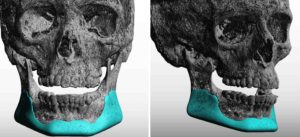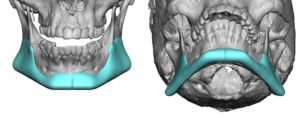Background: Changing the shape of the lower face is most effectively done by skeletal augmentation. While injectable filers and fat has a valuable role to play in enhancing facial volumes, they are not effective ‘perimeter’ augmentation methods. They are too soft to create a sharp line of demarcation which is what is needed in jawline augmentation.
The most effective implant method of jawline augmentation is with a custom design that encompasses the entire jawline. This is because it provides a complete inferior border expansion along the entire jawline. From angle to angle the skeletal contour is expanded either laterally, inferiorly and most commonly some of both dimensions. This collective circumferential effect makes the significance of its millimeter expansions more relevant than in a single more isolated implant. (e.g., chin implant)
The sheer size of a custom jawline implant makes its placement challenging since the incisional access is far shorter in length than that of the implant. Aiding the placement process is the incorporation of specific orientation markers into the implant’s design. These include a midline vertical chin groove and external oblique ridge extensions.
Case Study: This young male was interested in a total jawline augmentation to create a more distinct and visible jawline. Like many young men, however, he did not want it to be too strong or look too obvious that he had something done.



While any design can be made for a custom jawline implant there are numerous factors that go in getting it placed properly. It is not as simple as it looks when the design is sitting on the 3D skeletal scan images.
Case Highlights:
1) Custom jawline implants in men are best inserted through a combined submental skin and bilateral posterior vestibular incisions.
2) The midline marker on the implant allows for a central fixation point to be established which aids in the jaw angle implant positioning.
3) A custom jawline implant primarily enhances the inferior border of the mandible from side to side.
Dr. Barry Eppley
Indianapolis, Indiana


